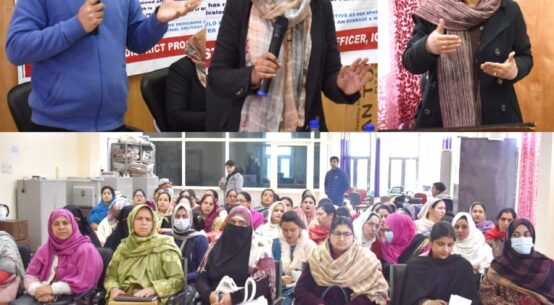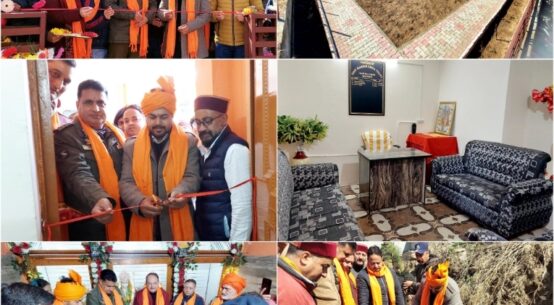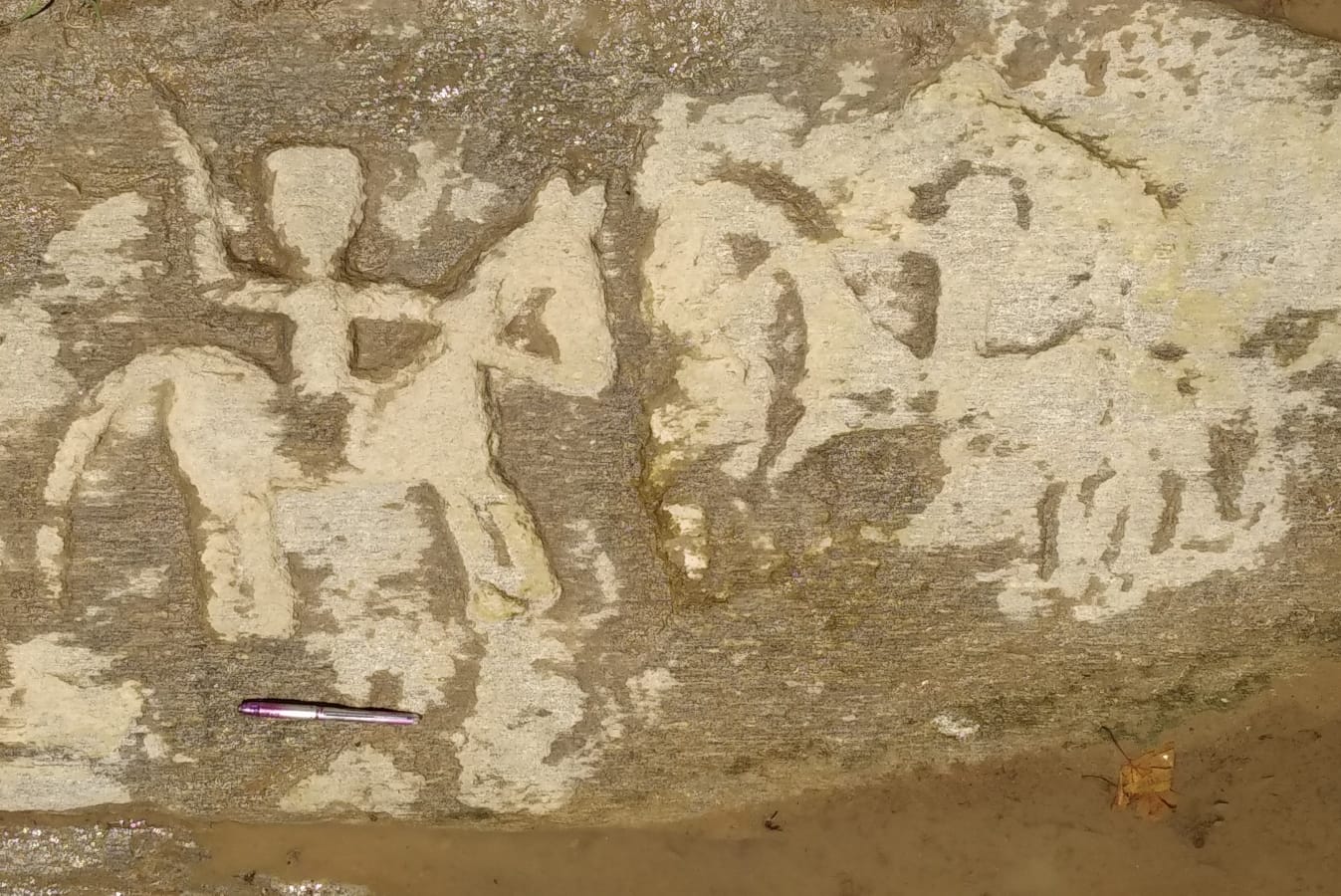
FIRST HISTORICAL KING OF KISHTWAR: A HISTORICAL CONTROVERSY
Authored By: Anil Kumar Bhagat
According to the books written on Kishtwar history, the first historical king of Kishtwar was Kahan Pal and almost every historian, author and writer related to this issue, was, and is agree with this name. But when we investigate this matter deeply, we come to know that this name was written for the first time in the first book written on kishtwar by Pandit Shivji Dhar in “Tariq – e – Kishtwar” published in 1962 AD. This name was taken from this book and later found in almost every historian’s book on kishtwar history. According to some authors Kahan Pal rule kishtwar in 5th century A.D. and some believe that his reign flourished in 8th or 10th century A.D.
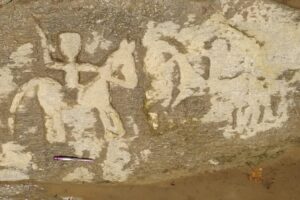
It is Historians view that Kahan Pal came here from Gour Bengal (present day Murshidabad in Bangladesh) and few writes that he belongs to the royal blood of Bengal and may be on the way to pilgrimage or might had run for his life with his followers and sympathizers, reached kishtwar and became the first historical king of kishtwar after defeating the local shield. If count on history books on kishtwar, he with his followers camped at Kandani (Drabhshalla) for four months of winter. He deployed his spies ahead in kishtwar to collect information, political loop holes and shortcomings there. Spies lured a woman of Panjsasis and extracted vital and classified information from her and returned to Kahan Pal who on the basis of information planned to capture the Kishtwar plateau. At that time there were three clans here Rathars, Ganies and Panjsasis, who were always fighting themselves. The most powerful clan among them was Panjsasis who always remained armed. This information was received by Kahan Pal through his spies. So he made a plan to kill or capture the clan of Panjsasis. He attacked the Panjsasis on the occasion of Kakul festival (this festival was in practice and falls in the month of February). Kahan Pal with his followers attacked Panjsasis near Hudri spring where they had gathered to bath and celebrate the festival. Kahan Pal emerged victorious as Panjsasis were totally unarmed then. After that Rathars and Ganies also surrendered and accepted his subordination. He then built a mansion at Tund and ruled the plateau till his last breathe.
BEYOND THE SHADOW OF DOUBT: EXPLORING REALITY
First of all, if we search in history of kishtwar by different authors, we find that they all are not unanimous at the arrival of the Kahan Pal at kishtwar. Some estimates in the 5th century, some in 8th century and some in 10th century A.D. Books on history of kishtwar run with a common name Kahan Pal that they get from a book Tarikh-e-Kishtwar written by the Pandit Shivji Dhar. But where did author get this name, from which history book or source or who told this name to him, there is no information about it. He simply wrote that “historically a king of Kishtwar Kahan Pal rule can be determined in 5th century A.D. Before this he wrote that the two families of Kashmir Rathars and Ganies came here and established their rule and a prince of Ladakh also made this area his adobe for some time”.
Some historians/authors believe that Kahan Pal was the successor of Harsha Vikramaditya of Ujjain and set out on Shri Amarnath Yatra with some followers and bodyguards. While passing through Kishtwar he developed some suspicions about the local political turmoil, and after staying here for some time, he won over local people and ruled here. Some authors wrote in their book that Shri Amarnath cave was not discovered then but was discovered in 18th century A.D.

But, according to Rag Prabhati, page no. 1332, Guru Nanak Dev ji reached to Amarnath cave via Ladakh. Here the author writes that after paying the obeisance at Amarnath cave, Guru Ji with his followers headed towards the Kashmir. On reaching at Amarnath valley they saw a huge crowd coming from Pahalgam to Amarnath Cave. Guru Nanak Dev Ji was born on 15 April, 1469 and leave for heavenly abode on 22 September, 1539 A.D.
In relation with the last Hindu King of Kashmir, Uadyan Dev, it is written that the King Uadyan Dev of Kashmir used to visit the Amarnath shrine to worship Tushar Linga. According to the Scriptures of Brigu Sahinta: Amarnath Mahatmayam, there was a law to bathe in twenty three pilgrimages on the route of Amarnath Yatra, six of these were in the river Vitsata and other seventeen bathe were in the waterfalls and holy ponds falling in the route to Amarnath.
“Shat Sananani Vitsatayam Prokatani Jagdamibake,!
Satdashsathalam Sathani Sathanani Sanananayavanayani Sunadari”!!
(Brigu Sahinta: Amarnath Mahatmayam)
This information reveals that Shri Amarnath cave has been in existence since ancient times, and devotes would visit to pay homage to Lord Shiva, and perhaps an annual pilgrimage was also a regular occurrence. Later on, people probably have stopped going there due to the natural, social or political reasons. After a long period, during the reign of Maharaja Gulab Singh, a shepherd named Adam Malik with his sheep and goats reached near the Amarnath Shrine. Adam Malik was a resident of the village named Vaktor near Pahalgam. First he told the Kashmiri Hindus living near Pahalgam about the Amarnath Cave. This implies that Shri Amarnath Yatra did not begin in 18th century A.D., but rather than has been a centuries old tradition.
Historians of kishtwar history writes that it may be established that ancestors of Kahan Pal fled away from Gour Bengal about 870 A.D., when Bhoja-I (836-90 A.D.), the Parthihara King of Avanti (Malwa), the capital of which was Ujjaini, invade Gaur Bengal and inflicted a crushing defeat upon Vigrapala, the then ruler of Gaur Bengal. May be the forefathers of Kahan Pal, Hari Pal and Manak Pal, with their sympathizers, like Gauria Brahmans and Barwalas, have accompanied him. They may have lived for some time in Ujjaini, the seat of the administration of their overlord. The subsequent events that took place in Ujjaini had made the decline of Parthihara dynasty evident. Kahan Pal, the successor of Manak Pal, may have thought it to leave Ujjaini and marched towards Chander Bhaga Zone to find Shelter some where there in the first half of 10th century.
The real name of Bhoja-I was Mihira Bhoja (836-885 A.D.). He was a ruler of the Gurjara-Parthihara dynasty of India. During his reign, the capital was in Kanauj (present day Uttar Pradesh). During his period Kanauj was referred as Panchala. He invaded Gaur Bengal in 873-874 A.D. This statement is supported by the three inscriptions of Narayanapala, dated in the years 7, 9, and 17, found in Bihar, seem to prove that the Kingdom of Magadha was in the possession at least up to his 17th year i.e., 871 A.D. Mihira Bhoja had defeated Narayanapala in 873-74 A.D. not Vigrahapala – I (850-854 A.D.). It is difficult to give a satisfactory explanation of this phenomenal success of Parthiharas and the complete collapse of the Palas during the latter half of the 9th century. Narayanapala ruled up to 908 A.D. and then his successors Rajyapala (908-940 A.D.), Gopala-II (940-960 A.D.), Vigrahapala-II (960-988 A.D.) and so on. This proves that Narayanapala was defeated by Mihira Bhoja but not totally crushed. Some part of his kingdom had been merged in the kingdom of Gurjara-Parthihara kingdom. Authors used the word “may be”, it means that they are not confident about the home land and ancestry of Kahan Pal. Also, we never find any clue about Hari Pal, Manak Pal or Kahan pal in the history Gouda Bengal or in the history of Gurjara-Parthihara dynasty. If they have lived in Ujjain after defeat, then they must be the war prisoners not citizen of Ujjain. So, it cannot be proved that Kahan Pal’s ancestors had firstly migrated from Gour Bengal to Ujjain and then to the Chandra Bhaga zone.
THE PALAS THAT RULED BENGAL
The Pala dynasty of Bengal was founded by Gopala – I in 750 A.D. followed by Dharampala, Devpala, Mahipala-I etc. Palas of Gour Bengal ruled the land from the early second half of 8th century A.D. were staunch Buddhists and patrons of Mahayana and Tantric Buddhism. They build important Buddhist centers of learning such as Odantapura, Vikramashila, Somapura Mahavihara, and grand temples and monasteries. They sent missionaries to other parts of India as well as to other countries to propagate the Buddhism.
History tells us that each and every King when invaded and subjugates any country, state or area, molded according to its own culture, faith, belief, religion and tradition. Many examples are there in the chest of Indian and world history. What Ashoka the Great did, Mughals, Britishers, etc. do, when subjugates maximum of Bharatvarsha. They tried to mold its culture, religion, traditions, faiths, education and everything what could be changed. If Kahan Pal had conquered the Kishtwar then he had propagated Buddhism and established monasteries and Buddhist learning centers here.
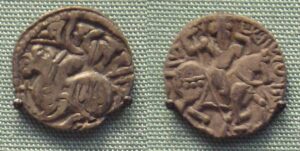
The distance between Gour Bengal and kishtwar is approximately 2000 K.M. and in between there are many principalities, states, and places. Kahan Pal with his band crossed all states and principalities and reached Kishtwar. They are acclimatizing of hot climate and plain areas. Their language, dresses, food habit, culture, tradition, way of worship, everything was different as compared to Himalayan Belt. Every individual tries to find a habitat which is favorable to him/her in all respects. They must have seen snow for the first time and have experienced blood clotting winter in their life. Then, how they had met their daily needs while halting at Kandani for four months with ladies and children during the winter season. Population of Kandani was not too good at that time because no book of Kishtwar history mentions Kandani and its subjects except the chapter of Kahan Pal’s halt.
Some historians write that Kahan Pal was accompanied by Gauria Brahmins, Rajputs and Barwalas. The detailed information of different caste members (Gouda Brahmans, Rajput, and Barwalas), who accompanied with Kahan Pal is as:
GAURIA BRAHMINS
Brahmins are traditionally divided into two regional groups: Pancha Gauda Brahmins (north India) and Pancha-Dravida Brahmins (south India). According to Kalhan’s Rajtarangani, “The karnatakas, Tailangas, Dravidas, Maharashtrakas, and Gurjaras; these five types who live south in Vindhaya mountains are called Dravida Brahmins; whereas Saraswatas, Kanyakubjas, Gaudas, Utkalas, and Maithilas, who live north of Vindhya mountains are known as five Gouda Brahmins. Collectively name for the five main northern Brahmin communities, the Gaudas and Kanyakubjas, who stretches over most of northern India, the Maithilas in the northern state of Bihar, the Utkalas in the coastal state of Orissa and the Saraswatas, traditionally found in several widely separated locations. One group lived in the coastal region in Sindh in modern Pakistan, although here too they have tended to migrate away from the part of Punjab in modern Pakistan. Third branch, known as the Gauda Saraswatas, is found on a narrow strip of coastline in the southern Indian state of Karnataka. The Saraswat community takes its name from Saraswati, patron Goddess of speech and learning and as a group is famous for its erudition and piety. From their main region of origin the Gaur Brahmans are spread all over India in parts like Rajasthan, Punjab, Haryana, Maharashtra, Jammu and Kashmir, Madhya Pradesh Uttar Pradesh, Goa, Uttarakhand etc.
After the attack of Mahmud of Ghazni, many Punjabi scholars of Sanskrit had fled to Schools and universities in Banaras and Kashmir, which were at the time unaffected by Islamic invasion. Al Biruni wrote, “Hindu sciences have fled far away from those parts of the country that have been conquered by us, and fled to the places which our hand cannot yet reach, to Kashmir, to Banaras and other places”.
Not a single book on history of Kishtwar gives us concrete evidence that Brahmins were the followers of Kahan Pal. If Kahan Pal belongs to royal blood of Gour Bengal, then he was also a Buddhists as all of his ancestors followed Buddhism. Then the possibility that Kahan Pal have brought Brahmins along with him is completely eliminated because the followers of Buddhism do not follow the customs, rite and rituals of Brahmins and Sanatan religion. There is possibility that the Brahmins of Kishtwar who traced their ancestry to Gour Bengal have migrated from Haryana, Punjab or any other place from North India to Kishtwar in 11th or 12th century A.D. or in following years. There is also a possibility that they might have been invited by the then Rajas of Kishtwar to perform Yaga and Hawan or other religious activities and after that they have been granted land and other things of survival and offered to stay here forever which must had been accepted by those Gouda Brahmins. If we go thoroughly in the history of ancient and medieval India, we found that the Kings invited Brahmans who were quite familiar with Vedic rites and rituals to perform Yagnas and also helped them to settle in their kingdom by granting them land and even villages.
RAJPUTS (RAJPOOT)
All books on history of Kishtwar tell us that Rathars and Ganies who invaded Kishtwar that originated from the border of Kishtwar and Kashmir and belongs to Rajput ancestry. Then we can say that they were the first Rajputs of kishtwar who settled here. Today we can see many sub castes of Rajputs in kishtwar, i.e., Parihar, Sen, Kotwal, Wazir, Shan, Rathore, Chouhan, etc.
BHARWALA (BAHAR WALA)
The Bharwala tribe is historically found in Sialkot (now in Pakistan), Gurdaspur and Hoshiarpur districts of Punjab, Jammu and Kashmir and in Himachal Pradesh. From ages, Bharwala is considered as the lowest caste of Hindu society and was employed as watchman, sweepers, drum beaters, cobblers and was given the assignments of all lower order task. Indeed the name of ‘Bharwala’ is a corrupted word/name of “Baharwala” or outsider, because like all outcasts, they live in the outskirts of the village. If, we closely have a look in all villages of Kishtwar district or in the villages of Kishtwar Plateau, we will find that every village has some population of lower castes from ancient times. Not only in Kishtwar, but every city, village or town has some Bharwalas or lower caste population. These peoples were used for lower order work. They cannot perform any of the offices assigned to the other three castes. So, we cannot conclude that Bharwalas were the followers of Kahan Pal.
If we try to find a person with this name (Kahan Pal) in the history of Bengal, Malva, of Ujjain then we don’t get anything because maybe there was no royal figure with this name.
PALA KINGS: THAT RULED KISHTWAR
Jayapala, son of Hutpala was the ruler of Hindu Shahi dynasty from 964-1002 A.D. His kingdom stretches from Laghman to Kashmir and Sirhind to Multan, with Peshawar being the center. Epithets from the Bari Kot inscription record his full title as “Parama Bhattaraka Maharajadhiraj Sri Jayapaladeva”. Jayapala is known for his struggles in defending his kingdom against the Ghaznavis in the modern-day eastern Afghanistan and Pakistan. He was defeated by Ghazani and immolated himself by fire in 1002 A.D. Jayapala’s son Anandpala (1002-1008) carried on the struggle, but was defeated by Gazani at Peshawar in 1008 A.D. Some of the Shahi Hindu princes eventually exiled themselves to the Siwalik Hills and in Middle Himalayan Ranges.
In the eleventh century Kashmir sent an army to help the Hindu Shahi King Tirlokapala against Mahmud of Ghazni. In this campaign the Shahi kingdom was completely destroyed, and many of the leading men must have escaped and emigrated. Some of the migrated to Kashmir and settled there. Kalhana’s Rajatarangni does not give a systematic account of immigrant Shahi’s but three generations of the can be clearly identified who enjoyed power and influence. The three Shahi brothers namely Rudrapala, Diddapala, Anangapala had great influence on the Kashmirian King Ananta (1028-63 A.D.). Rajatarangni vol.-I translated by M.A. Stein on Page no. 109 writes that ‘during the early part of Ananta’s reign (A.D. 1028-1063) princes of the Hindu Shahi family like Rudrapala, Kshempala, Angangpala and Diddapala, who had found a safe refuge in Kashmir, exercised great power in the land. Kalhan illustrates the position of these royal refuges by indicating the great subsidies paid to them.’ Further, he writes that Rudrapala had married a daughter of Induchandra and king Ananta marry Suryamati, a younger daughter of Induchandra.
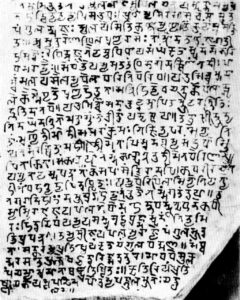
The first Raja of Rajapuri state (present day Rajouri) referred to the Rajatarangni was Prithvi Pala, about 1000-1025 A.D., in the reign of Queen Didda. He was succeeded by Shahaja Pala who reigned up to 1050 A.D. He was then followed by Sangram Pala and so on. The Rulers of Bhadu State (now Ramkot) also used suffix Pala after their names. Some examples are, Bhog Pala, Som Pala, Tunga Pala, Kalas Pala, Bikram Pala, Nardhan Pala, Gaur Pala, Dharam Pala etc. According to Pandit Kalhana in Rajatarangni, Rudrapala, Diddapala and Anangapala were the princes of Shahi Pala Dynasty that took refuge in Kashmir after having gulf with Mahmud Gazani. All these states were situated on the east side of Kishtwar connecting to Kabul and Gandhara (areas of Afghanistan). The Hindu Kings of Kabul and Gandhara had links with some ruling families in neighboring Kashmir, Punjab and other areas to the east.
Mahmud Gazani had intention to invade to Kashmir and its peripherals. In the year 999 A.D. (406 of Hijiri), Gazani made a plan of conquering the Kashmir, and when he went there he besieged the strong fort at Lohkot, but when a long time had elapsed and much snow fell, and the cold become extreme and reinforcements beyond number had reached the fort,
he raised the siege and started back to Gazani.
CONCLUSION
One thing is clear from all this that Kahan Pal was also from the royal family of Hindu Shahi dynasty of Kabul valley. Some Hindu Shahi princes took refuge in Kashmir and other parts of Himalayan belt and there is possibility that one of the princes or a member of royal family must have come to kishtwar with his well wishers and captured it after knowing the situation here. The successors of Kahan Pal used suffixes i.e., Sen, Dev and Singh after their names. All these suffixes are still in practice in the Punjab and its adjacent areas and states. There is a question, why Gandarb Sen son of Raja Kahan Pal changed his suffix from Pal to Sen? There is possibility that Gandarb Sen was aware of Mahmud Gazani’s ambition and invasion as he and his father Kahan Pal had faced him. He might have fear that Gazani may trace out them by their suffix Pala and invade Kishtwar. So, they changed their surname from Pala to Sen.

The first authentic information about Kishtwar and its rulers on which we can count is written in Rajatarangni by Pandit Kalhana. According to Kalhana’s Rajatarangni translated, In the year 63 Kashmirian era (1087-88 A.D.), eight Kings came to the King Kashmira and entered the capital, namely, Kirtti King of Nyarvvapura (Nilpura), Asata King of Champa, Kalasha son of Tukka and King of Vallapura, Sangrampala king of Rajouri, Utkarsha King of Lohara, Munggaja King of Urvasha, Gambhirasiha King of Kanda, and Uttamraja King of Kashthavata (Kishtwar). The streets of the capital were crowded so that they could hardly be seen. They were comfortably lodged there when the waters of the Vitsata were frozen. Uttamraja (Oudat Dev) was identified as King of Kashthavata (Kishtwar) by Pandit Kalhana. Raja Oudat Dev was son of Raja Braham Sen and ascended the throne after the death of his father. This fact further strengthens the possibility that the king of kishtwar had relations with the kings of Kashmir or perhaps they were related to each other or belonged to the same family.
EVIDENCES OF SHAHI PALAS THAT STILL EXISTS IN KISHTWAR
Despite being overlooked, numerous proofs still exist in Kishtwar or may have been found, but due to lack of proper investigation and examination, they remained hidden from our sight, reach and knowledge. Certain relics may have been submerged under the passage of time or ravaged by natural disaster or accidently destroyed or laid waste by human endeavors. I have compiled some of these and am sharing them with readers visually. I believe that we should conduct further research in this context, as there may still be numerous evidences hidden somewhere as stone inscription, in temples, caves, and in literary works, which remains inaccessible to us.
Author: Anil Kumar Bhagat
Email: anilk11111982@gmail.com
Contact: 7051350159
Disclaimer: This article presents the author’s personal research and interpretation of historical events. www.mykishtwar.com provides this platform for the dissemination of information and diverse perspectives. The accuracy, completeness, and validity of any statements made within this article are solely the responsibility of the author. The content of this article is the sole responsibility of the author. www.mykishtwar.com does not assume any liability for the information presented. The author’s views and opinions do not necessarily represent those of www.mykishtwar.com. Readers are encouraged to conduct their own research and verify the information presented.
